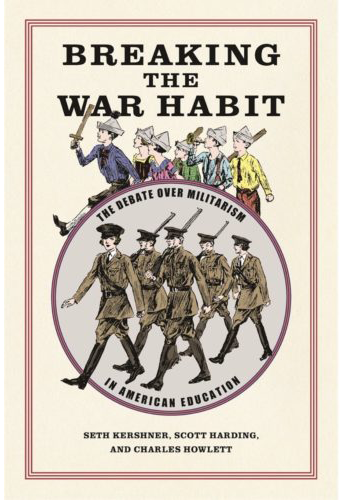A first of its kind, "Breaking the War Habit" — focuses on the historical and contemporary role of the military’s involvement in American education. October 3, 2022 / Maynard Seider / The Berkshire Edge - At a time when bipartisan support for war and its funding has not been higher, and when any opposing sentiment earns one the label of “Putin apologist,” if not censored, a new book entitled “Breaking the War Habit” and co-authored by a Berkshire County writer, is welcome news.
October 3, 2022 / Maynard Seider / The Berkshire Edge - At a time when bipartisan support for war and its funding has not been higher, and when any opposing sentiment earns one the label of “Putin apologist,” if not censored, a new book entitled “Breaking the War Habit” and co-authored by a Berkshire County writer, is welcome news.
A first of its kind, the book focuses on the historical and contemporary role of the military’s involvement in American education. Currently, recruiters visit some high schools as much as 100 times a school year, and military officials teach a Junior Reserve Officer Training Corp (JROTC) curriculum in more than 3,200 high schools that enroll more than 550,000 student “cadets.” Not so long ago, mandatory enrollment in ROTC at the college level was commonplace. Now, it still exists in some form in over 1,700 colleges and universities. At the same time, resistance to military programs in America’s high schools and colleges has a rich history. This history is well told by the authors.
Subtitled “The Debate Over Militarism in American Education,” the book’s lead author is Seth Kershner, a University of Massachusetts Ph.D. candidate in history from Sandisfield, and his collaborators are Scott Harding and Charles Howlett. They trace the first opposition to militarism in the country’s schools to the preeminent educational reformer, Horace Mann, who in the 1830s “insisted that schoolchildren learn that war is not heroic and demanded that history textbooks devote less attention to the subject.” In a pattern that will repeat itself well into the 20th and 21st centuries, however, the coming of war and war itself valorized military values and demanded loyalty to that end.
In fact, during the Civil War, in 1862, the government passed the Land-Grant College Act (the Morrill Act) which gave subsidies and land to state colleges with the proviso that their male students be enrolled in military training programs, the precursor of ROTC. At the same time, some high schools introduced military training programs, though federal funding for secondary level training wouldn’t become a reality until World War I.
The National Network Opposing the Militarization of Youth (NNOMY)
Articles
Military recruiters count on economic hardship to lure young people of color to sign up. Counter-recruiters are working hard to thwart their efforts. Sep 6, 2022 / Aina Marzia / YES! Media - Year after year, the same foldable table is propped up near the entrance of a high school gym. People with the same uniform but different faces, all eager to tell you about a new “opportunity,” will sit idly at the table. There will be a sign in front of the table and a clipboard on top, ready to jot down any name that will take the bait being offered.
Sep 6, 2022 / Aina Marzia / YES! Media - Year after year, the same foldable table is propped up near the entrance of a high school gym. People with the same uniform but different faces, all eager to tell you about a new “opportunity,” will sit idly at the table. There will be a sign in front of the table and a clipboard on top, ready to jot down any name that will take the bait being offered.
The U.S.’s “all-volunteer military” requires people, and the search for young high schoolers to fill the ranks of the armed forces is always ongoing. Further, the military tends to prioritize recruiting low-income minority kids because, as per Anthony Clark, a U.S. Air Force veteran, “Poverty is the draft.”
Racial and Socioeconomic Discrepancies in Enlistment
From embedding militarism into public schools to setting up shop inside schools, the military will seemingly go to any lengths necessary to get more boots on the ground. Programs like Junior Reserve Officers’ Training Corps (JROTC), while not directly affiliated with recruiters, attract large enlistments from high schoolers and are introduced to students as early as freshman year. In a report by RAND Corporation in 2017, it is estimated that more than 500,000 students are enrolled in Army training programs. Further, 56% of schools with such programs offered federal reduced or free lunch options, suggesting that they serve students near or below the poverty line.
According to the Council on Foreign Relations, around 64% of enlistments are of people from household incomes below $87,000, and 19% are from household incomes below $41,691. Although the CFR classifies such people as “middle income,” many social scientists point out the increasing financial precarity of the American middle class, such as Alissa Quart’s 2018 book Squeezed: Why Our Families Can’t Afford America. Such research highlights how the middle class is shrinking, making income data unreliable when assessing economic hardship. While there is a common belief that the armed forces are an “all-volunteer military,” the data suggests that low-income students often view the military as an economic opportunity.
 May 17, 2022 / Mennonite Church USA | Mennonite Central Committee / Anabaptist World - Mennonites Against Militarism — a collaboration of Mennonite Central Committee U.S. and Mennonite Church USA — is planning an initiative to counter military recruitment of U.S. youth.
May 17, 2022 / Mennonite Church USA | Mennonite Central Committee / Anabaptist World - Mennonites Against Militarism — a collaboration of Mennonite Central Committee U.S. and Mennonite Church USA — is planning an initiative to counter military recruitment of U.S. youth.
Alternatives to Military Enlistment Network will connect young people with volunteer advisers who can help them find nonmilitary career, service and training opportunities.
Mennonites Against Militarism invites volunteers to complete an online survey at mennoniteusa.org that identifies areas they may engage with AMEN, including administration, web and graphic design, publicity, budgeting, fundraising and guidance/career counseling. Veterans and others who understand war and military recruitment are also encouraged to complete the form.
“This project goes beyond traditional counter-recruitment efforts by working with individual youths to find meaningful opportunities,” said Titus Peachey, retired coordinator of peace education for MCC. “In a highly militarized society, it is a practical way to embody our faith commitment to peace.”







